Analysis of Four Types of Anchorage Devices for Prestressed Glulam Beam and Experimental Research
Abstract
:1. Introduction
2. Finite Element Experiment
2.1. Finite Element Modeling
2.2. Constitutive Model
2.3. Material Properties
2.4. Finite Element Simulation
3. Results and Discussion
3.1. Load-Deflection Curves
3.2. The Bending Stress Distribution
3.3. Impact of Initial Upward Pre-Deflection
3.4. Impact of the Initial Top Pre-Stress
4. Experimental Research
4.1. Mechanical Properties of Materials
4.2. Testing Procedure
4.3. Bending Test
4.4. Failure Modes
4.5. Load-Deflection Curves and Bearing Capacity
5. Conclusions
- Compared with the Glulam beam, prestressed beams with four types of anchoring devices could be obviously improved. When the prestress is 1 MPa, 1.5 MPa and 2 MPa, the bearing capacity is increased by 101.71–172.57%, 105.85–175.88%, and 109.64–180.87%, respectively; when the top deflection is 5 mm, 10 mm and 15 mm, the bending performance of the prestress beams is improved by 80.37–177.24%, 93.56–182.51%, and 95.62–194.60%;
- Under different prestress and pre-deflection values, the stiffness and bearing capacity of prestressed beam with the mode I is the highest; but the bearing capacity of prestressed beams with the mode III gets the hugest improvement with the initial top stress increasing. Compared with 1 MPa prestressed beams, the bearing capacity of 1.5 MPa and 2 MPa prestressed beams is increased by 8.51% and 11.77%, respectively; compared with the beam with pre-deflection of 5 mm, the bearing capacity of the beam with pre-deflection of 10 mm and 15 mm is increased by 13.30% and 24.67%, respectively;
- Compared with the stress distribution of the other three kinds of prestressed beams, the beam with mode I is most uniform. Therefore the properties of the raw material could be fully utilized;
- Experimental data show the failure mode of the prestressed tested beams is the brittle failure. Compared between experimental results and simulation results, the simulation could better predict the basic linearity of the load-displacement curve, ultimate bending capacity, and the failure mode.
Author Contributions
Funding
Institutional Review Board Statement
Informed Consent Statement
Data Availability Statement
Conflicts of Interest
References
- Canada Wood. Structural types and advantages of modern wood structure buildings. Int. Wood Ind. 2020, 50, 10–11. [Google Scholar]
- Jochen, K.; Staffan, S. Probabilistic representation of the duration of load effects in timber structures. Eng. Struct. 2011, 33, 462–467. [Google Scholar]
- Haiyan, Z.; Qian, L. The Application of the Wooden Structure to the Canadian School Buildings. New Archit. 2020, 6, 110–113. [Google Scholar]
- Yue, C. American medium and high-rise wood structure buildings. Constr. Sci. Technol. 2019, 17, 31–34. [Google Scholar]
- Chengmou, F.; Shengzhe, N. Modern Wood Structure; Harbin Institute of Technology Press: Harbin, China, 2007; Volume 10, pp. 1–5. [Google Scholar]
- Josef, K. Multi-Story Timber Structure; Birkhäuser: Basel, Switzerland, 2008; pp. 188–200. [Google Scholar]
- Ehrhart, T.; Steiger, R.; Lehmann, M.; Frangi, A. European Beech (Fagus sylvatical L.) Glued Laminated Timber: Lamination Strength Grading, Production and Mechanical Properties. Eur. J. Wood Wood Prod. 2020, 78, 971–984. [Google Scholar] [CrossRef]
- Zhonghua, H. A Study on Joint Finger Technique for Laminations in the Structural Larch Glulam. Master’s Thesis, Chinese Academy of Forestry Sciences, Beijing, China, 2012. [Google Scholar]
- Liqing, L. Development of the glued-laminated timber structure housing. China Build. Mater. Sci. Technol. 2008, 17, 63–66. [Google Scholar]
- Xu, S. Experimental Research on Flexural Performance of Reinforced Glulam Beams; Northeast Forestry University: Harbin, China, 2016. [Google Scholar]
- Aijun, C.; Guojun, C.; Guosheng, C.; Wang, X.; Peng, R. Experimental study on the mechanical behavior of Glulam timber beams reinforced with BFRP. J. Cent. S. Univ. For. Technol. 2019, 39, 107–113. [Google Scholar]
- Yishi, L. Experimental Study on Flexural Behavior of Flax Fiber Reinforced Polymer Reinforced Glulam Beams; Northeast Forestry University: Harbin, China, 2020. [Google Scholar]
- Feibin, W.; Xiaolin, Y. Study on Bending Behavior of Glulam Beams Reinforced with Bonded-in GFRP Rods. China For. Prod. Ind. 2017, 44, 18–23. [Google Scholar]
- Ivan, G.; Boško, S. Flexural Reinforcement of Glulam Beams with CFRP Plates; Springer: Dordrecht, The Netherlands, 2016; Volume 49, pp. 2841–2855. [Google Scholar]
- Johnsson, H.; Blanksvärd, T. Glulam members are strengthened by carbon fiber reinforcement. Mater. Struct. 2007, 40, 142–149. [Google Scholar] [CrossRef]
- Juliano, F.; Antonio, A. Glulam beams reinforced with FRP externally-bonded: Theoretical and experimental evaluation. Mater. Struct. 2011, 44, 1431–1440. [Google Scholar]
- Khelifa, M.; Celzard, A. Numerical analysis of flexural strengthening of timber beams reinforced with CFRP strips. Compos. Struct. 2014, 111, 393–400. [Google Scholar] [CrossRef]
- Fava, G.; Carvelli, V. Pull-out strength of glued-in FRP plates bonded in Glulam. Constr. Build. Mater. 2013, 43, 362–371. [Google Scholar] [CrossRef]
- Valipour, H.; Crews, K. Efficient finite element modeling of timber beams strengthened with bonded fiber-reinforced polymers. Constr. Build. Mater. 2011, 25, 3291–3300. [Google Scholar] [CrossRef]
- Jin, Z.; Weichang, W. Experimental study on short-term flexural behavior of internal prestressed Glulam beams. China Civ. Eng. J. 2019, 52, 23–34. [Google Scholar]
- Huifeng, Y.; Dongdong, J. Prestressed Glulam beams reinforced with CFRP bars. Constr. Build. Mater. 2016, 109, 73–83. [Google Scholar]
- Cheng, L.; Huifeng, Y. Experimental Study on the Flexural Behavior of Prestressed Glulam Beams. Struct. Eng. 2014, 30, 160–164. [Google Scholar]
- Jin, Z.; Hao, S. Short-Term Flexural Behavior of Prestressed Glulam Beams Reinforced with Curved Tendons. J. Struct. Eng. 2020, 146, 04020086. [Google Scholar]
- Yang, W.; Shaocong, Y. Experimental and theoretical investigation of steel-reinforced bamboo scriber beams. Eng. Struct. 2020, 223, 111179. [Google Scholar]
- McConnell, E.; McPolin, E. Post-tensioning of Glulam timber with steel tendons. Constr. Build. Mater. 2014, 73, 426–433. [Google Scholar] [CrossRef] [Green Version]
- Negrao, J. Preliminary study on wire prestressing methods for timber pieces reinforcement. Constr. Build. Mater. 2014, 102, 109–110. [Google Scholar] [CrossRef]
- Ansari, B.; Guan, Z. Structural behavior of glued laminated timber beams prestressed by compressed wood. Constr. Build. Mater. 2011, 29, 24–32. [Google Scholar] [CrossRef]
- Yubin, Z.; Wen, L. Prestress loss of prestressed Glulam beam reinforced with FRP. World Earthq. Eng. 2019, 35, 99–107. [Google Scholar]
- Lidan, M.; Nan, G. Study on flexural performance of prestressed Glulam continuous beams under control influence. J. Wood Sci. 2021, 67, 48. [Google Scholar]
- Mario, V.; Alessandra, J. A Semi-Linear Elliptic Model for a Circular Membrane MEMS Device Considering the Effect of the Fringing Field. Sensors 2021, 21, 5237. [Google Scholar]
- GB/T 1935-2009. Methods of Testing in Compressive Strength Parallel to Grain of Wood; Standardization Administration of China: Beijing, China, 2009.
- GB/T 50329-2012. Standard for Test Methods of Timber Structures; Standardization Administration of China: Beijing, China, 2012.
- Mingtao, W.; Nan, G. Bending Performance of Prestressed Continuous Glulam Beams. Adv. Civ. Eng. 2021, 2021, 5512350. [Google Scholar]
- GB/T 50005-2017. Standard for Design of Timber Structure; Standardization Administration of China: Beijing, China, 2017.
- Lidan, M.; Nan, G. Influence of the Force Arm on the Flexural Performance of Prestressed Glulam Beams. Adv. Civ. Eng. 2021, 2021, 8831406. [Google Scholar]
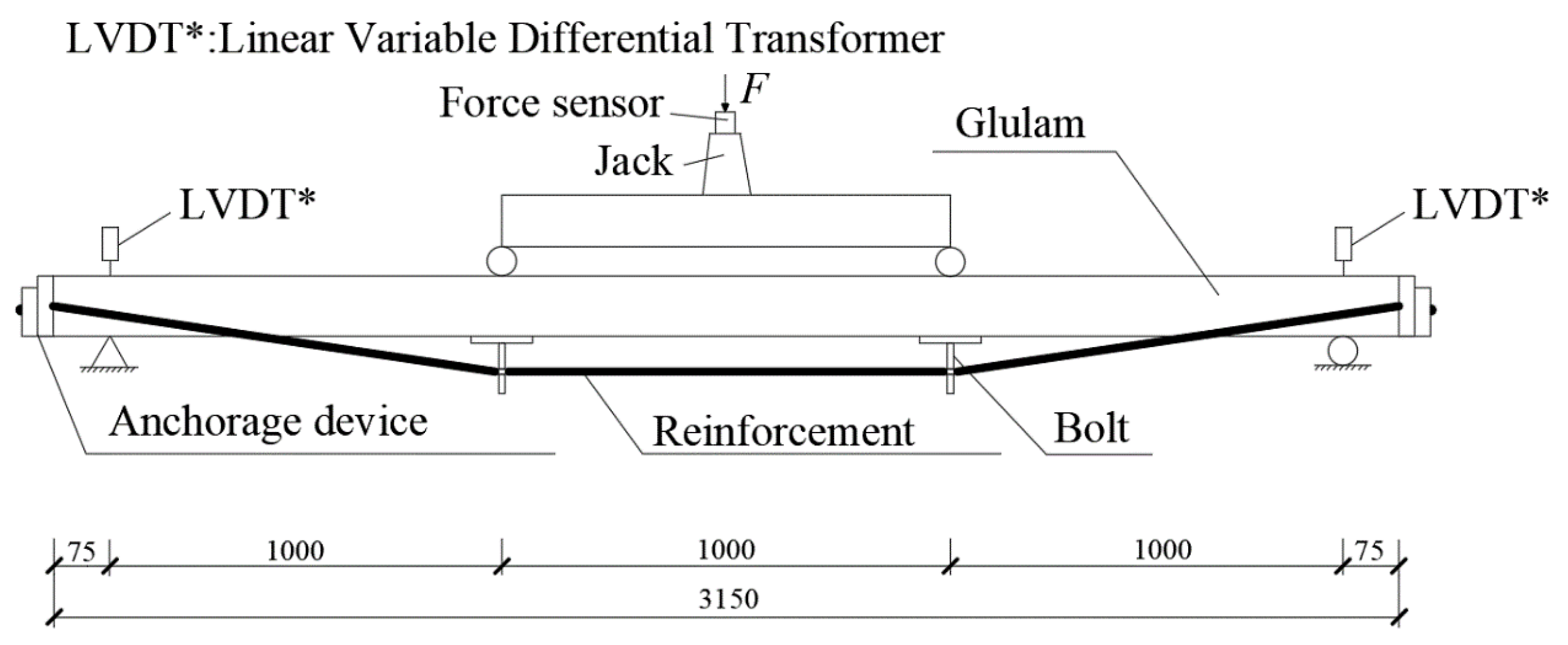
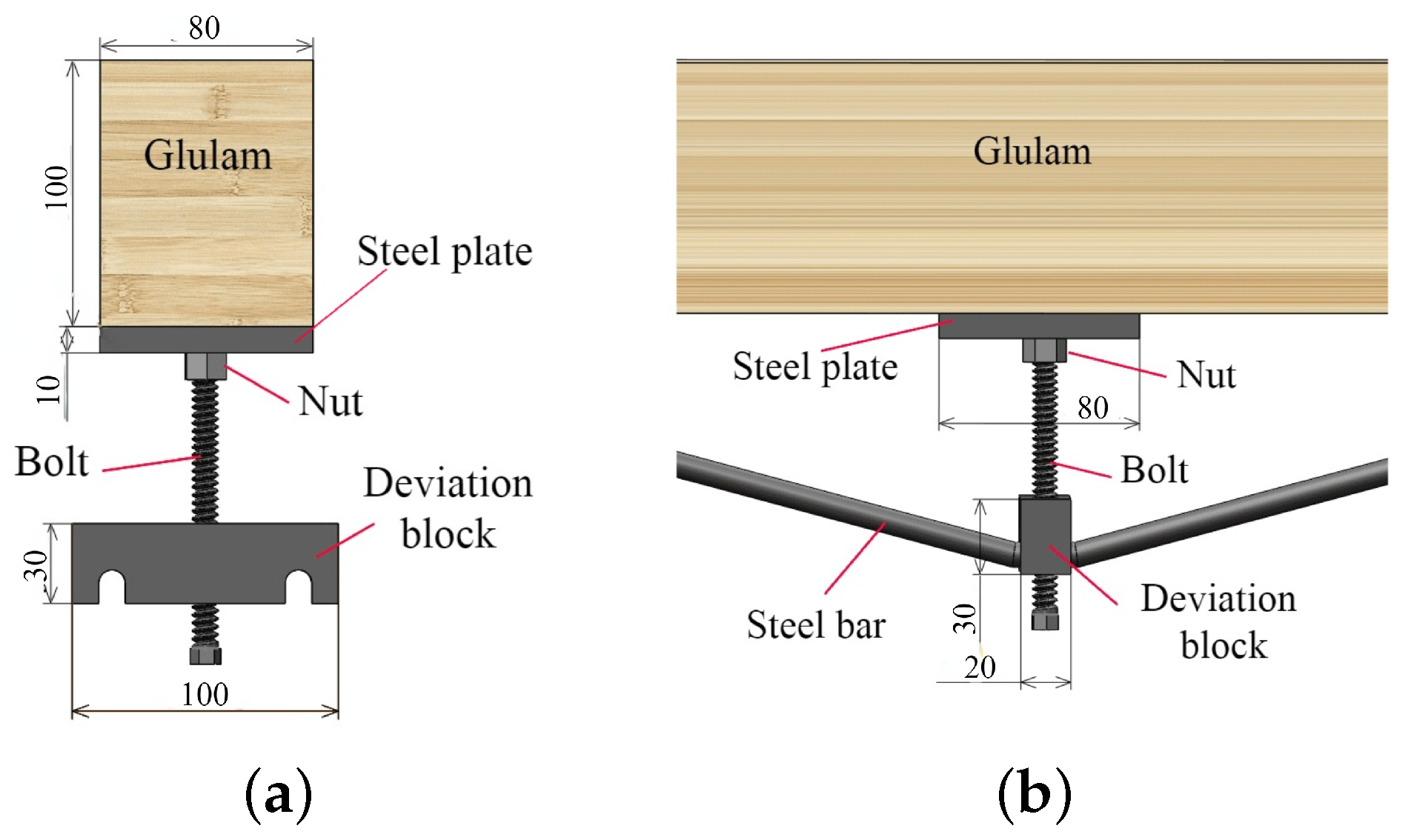
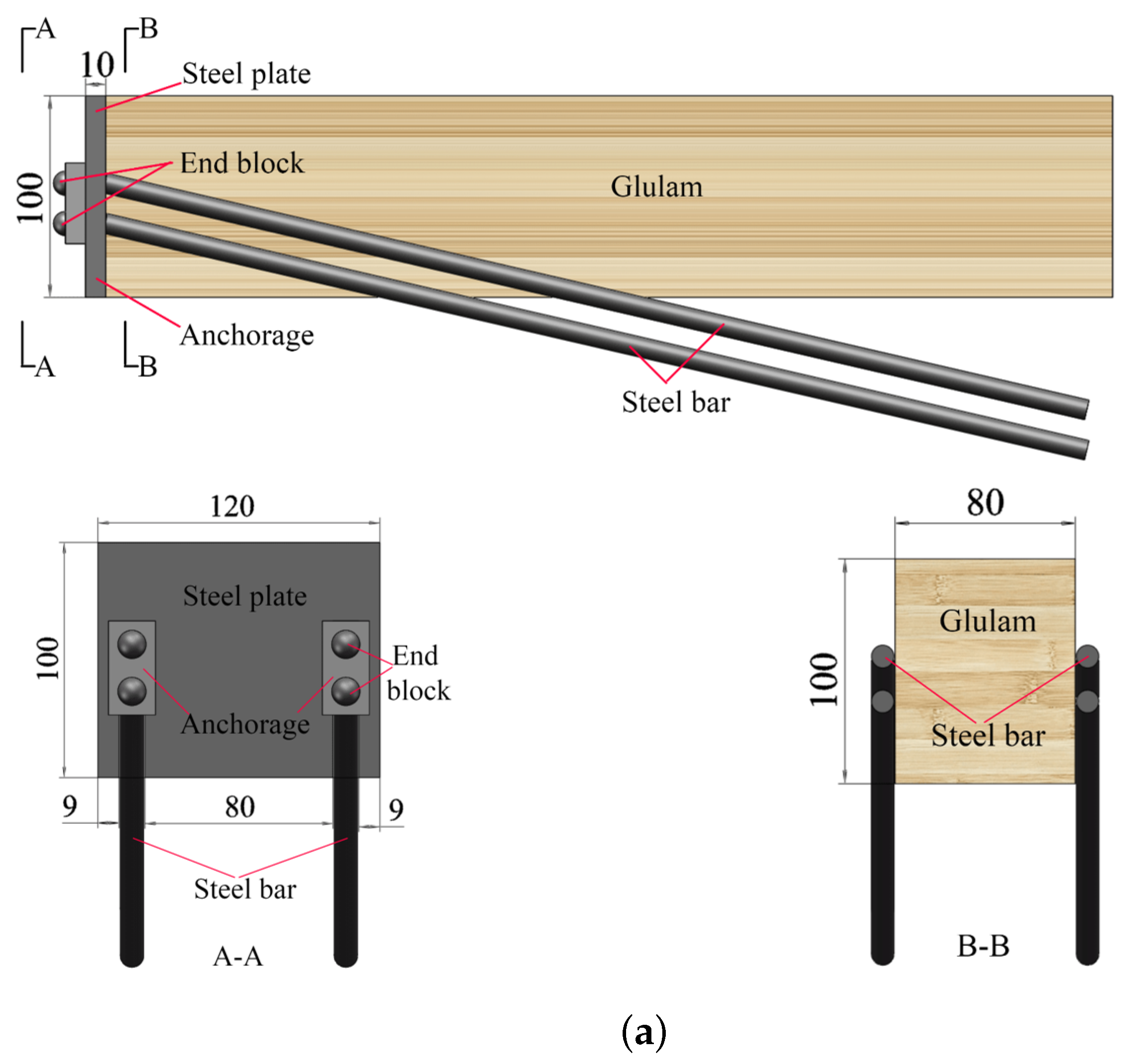
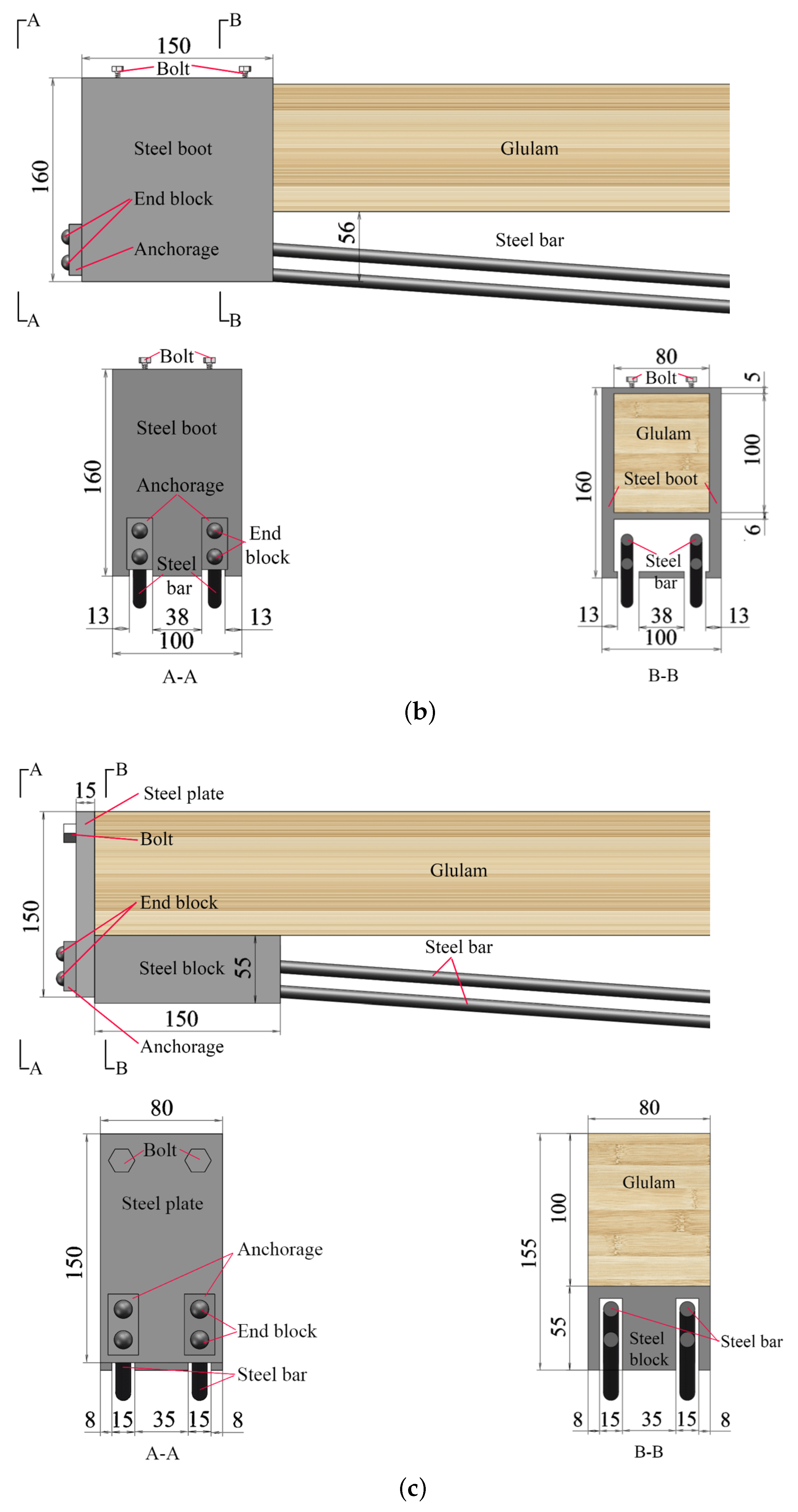
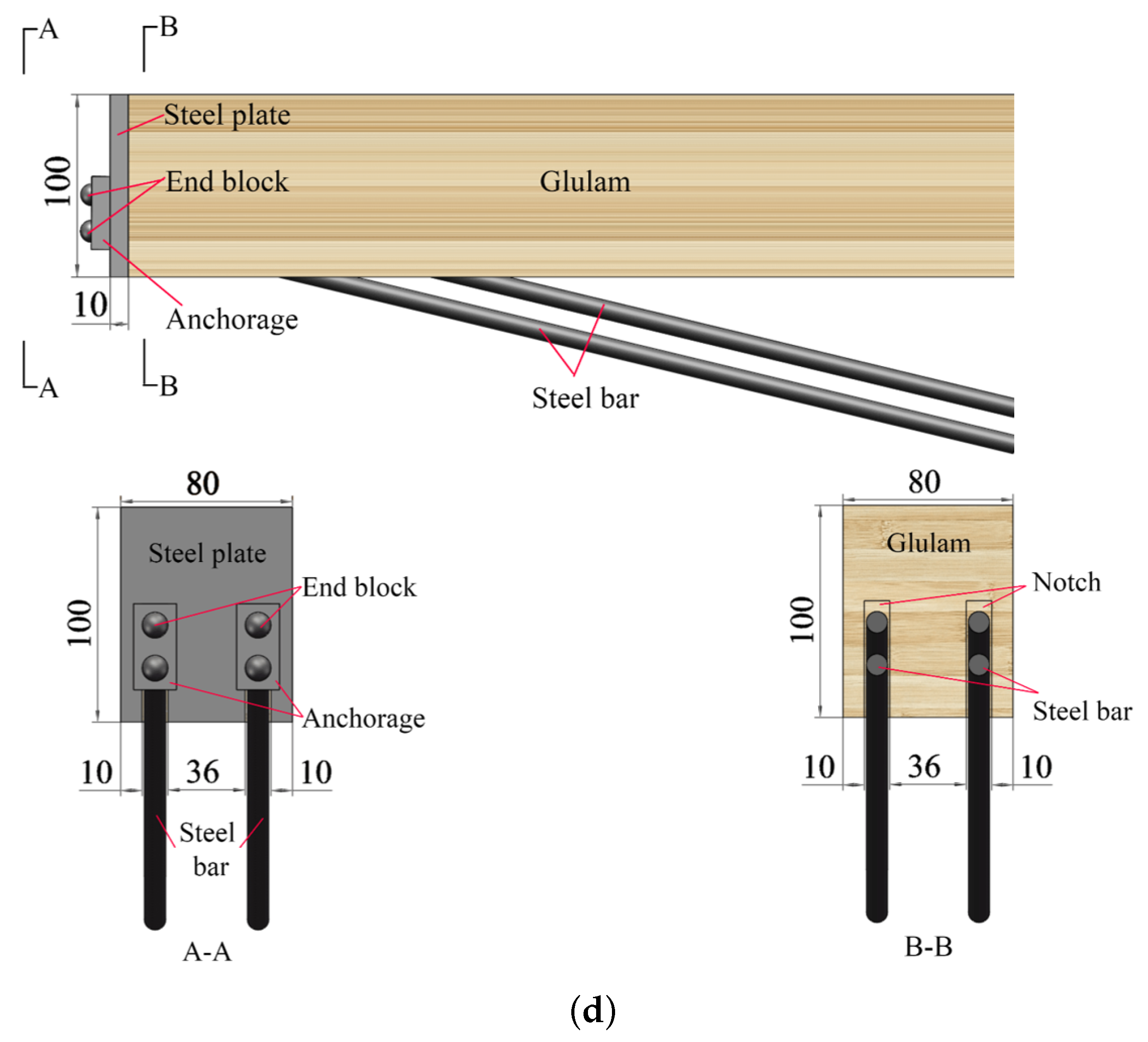
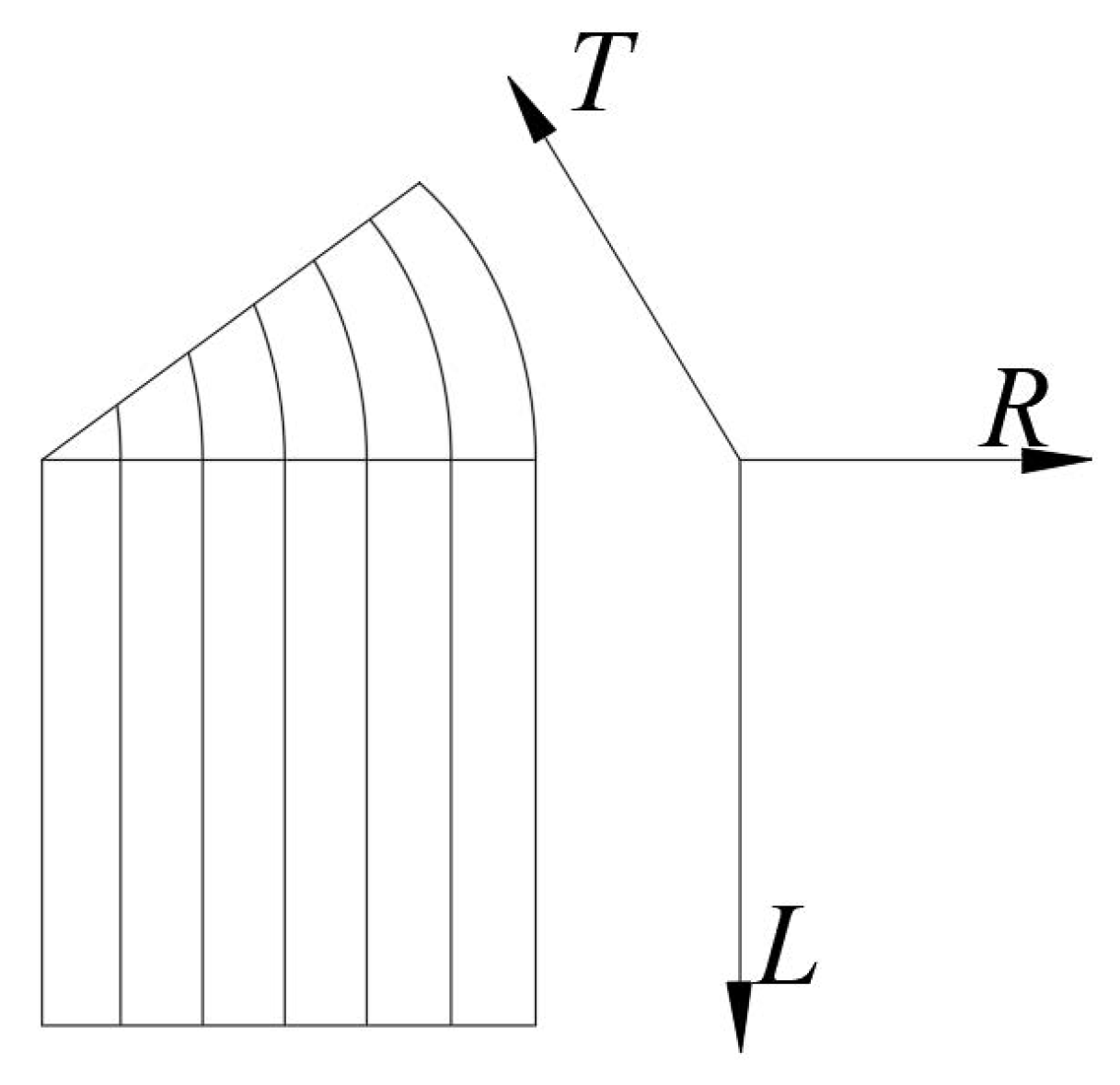
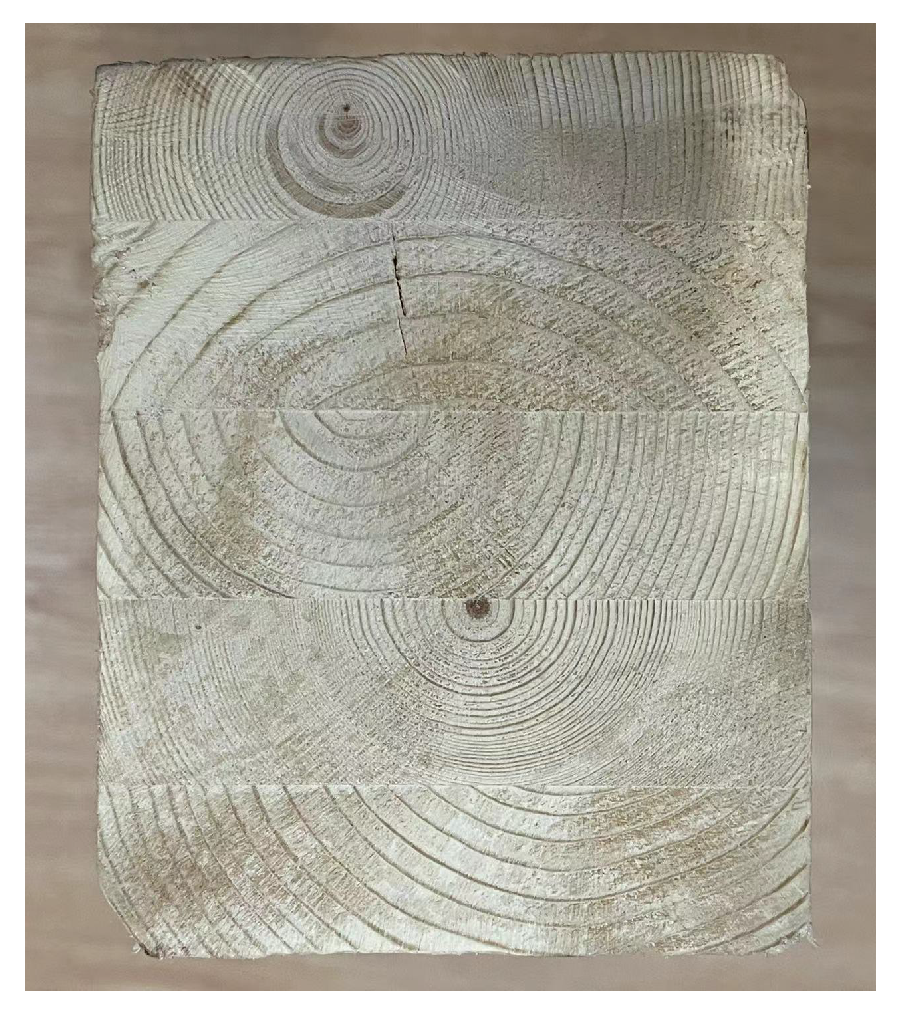

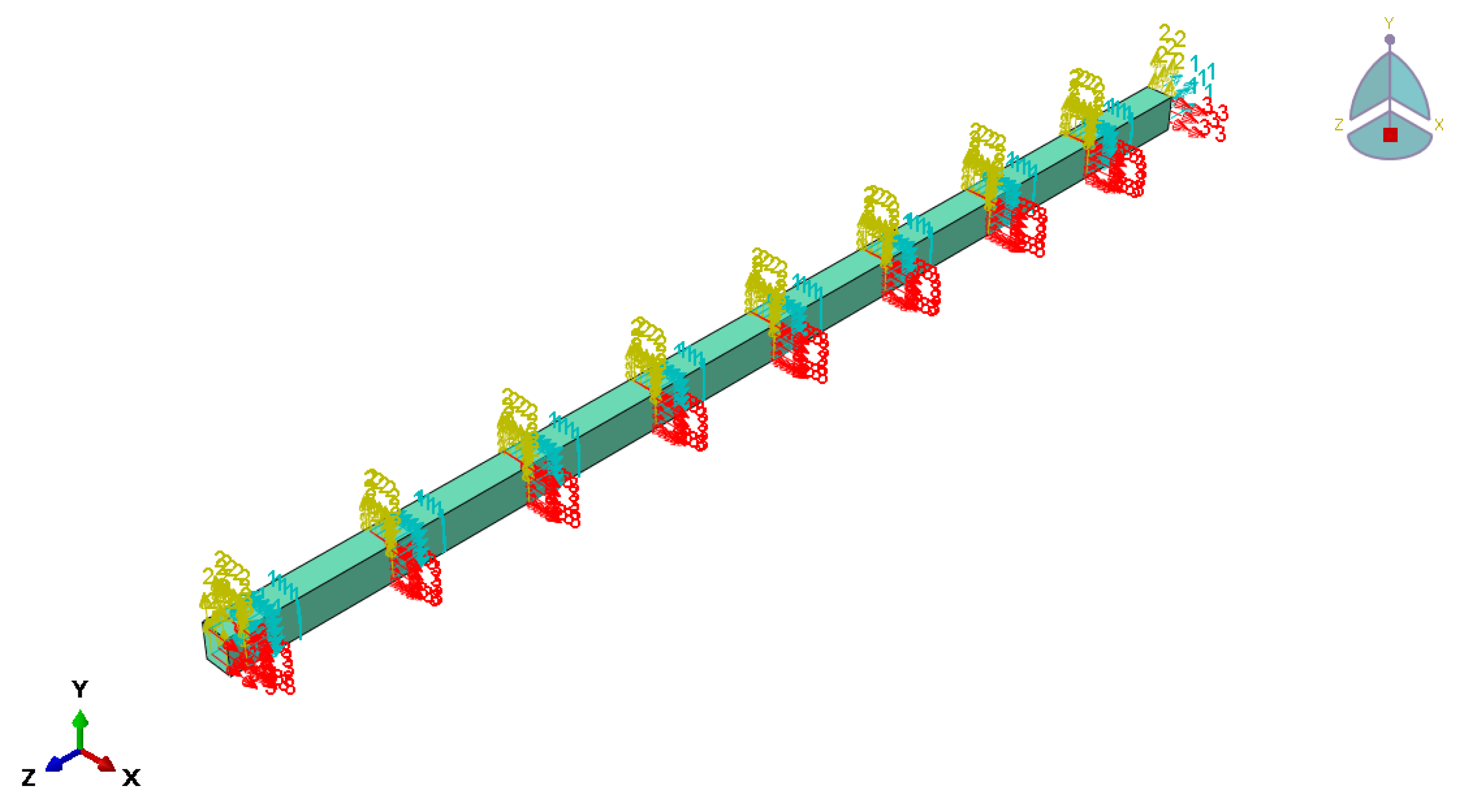

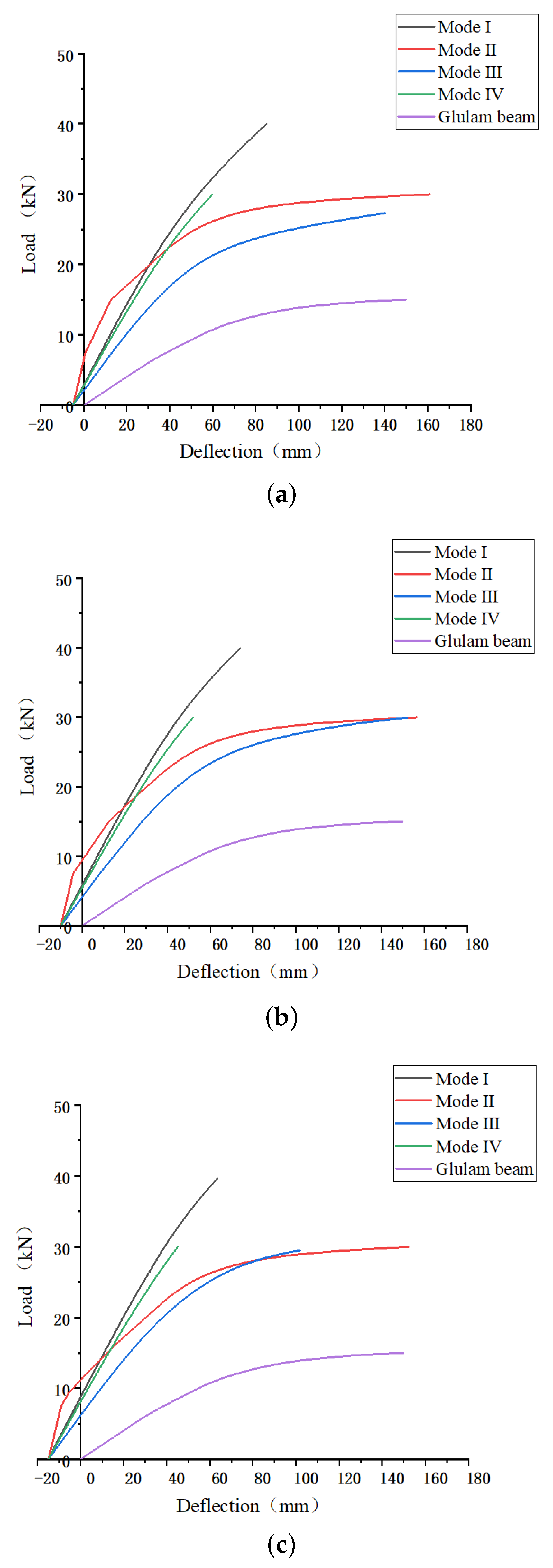
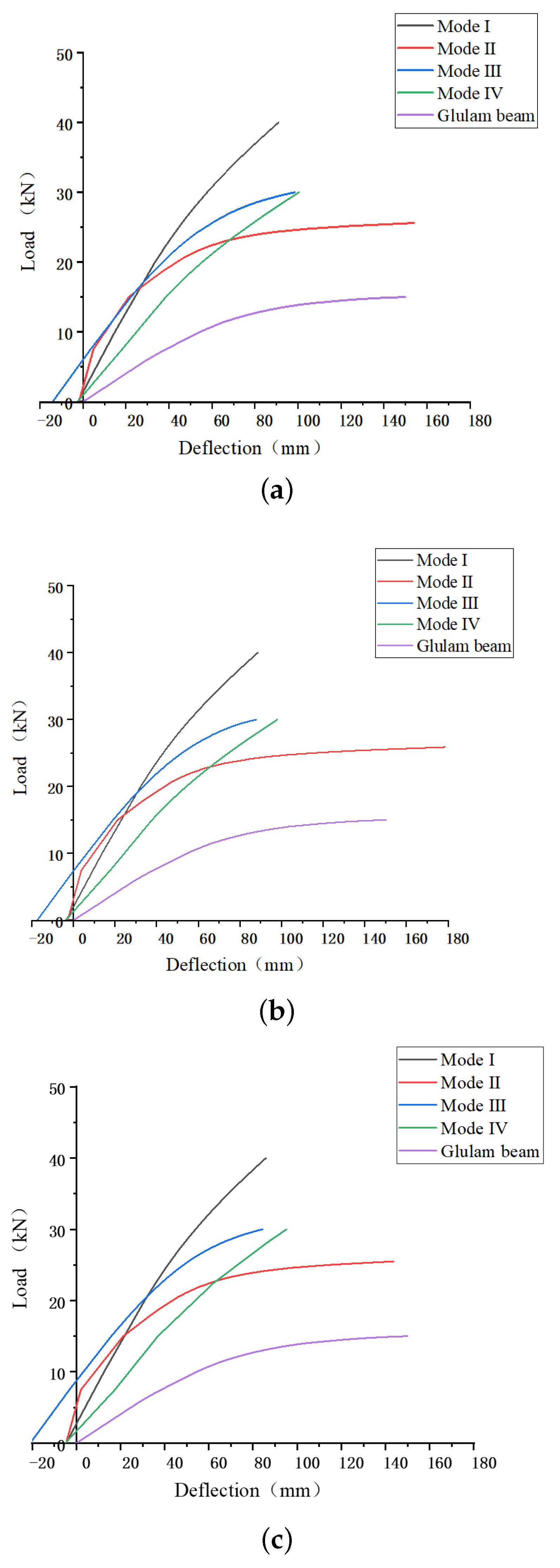
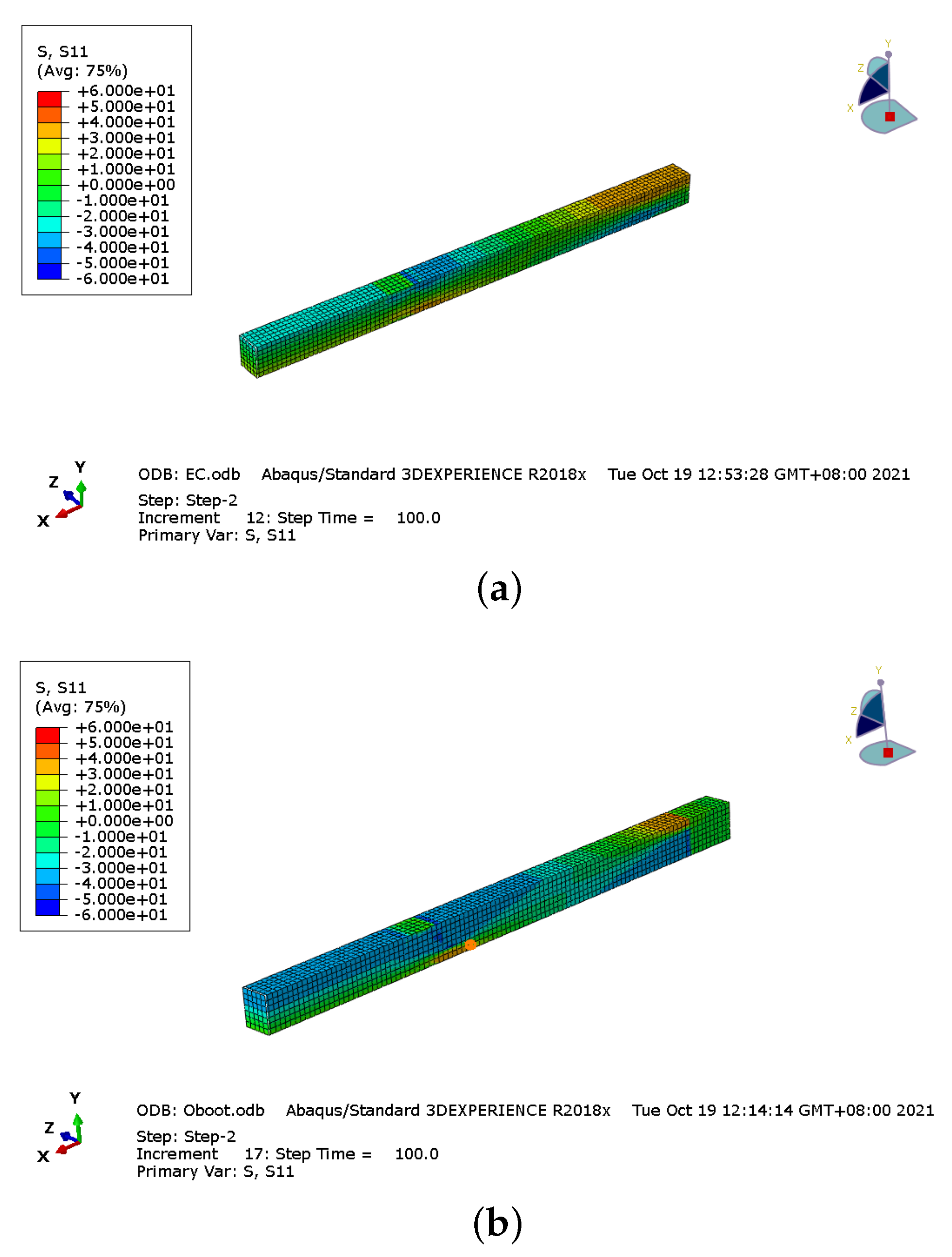
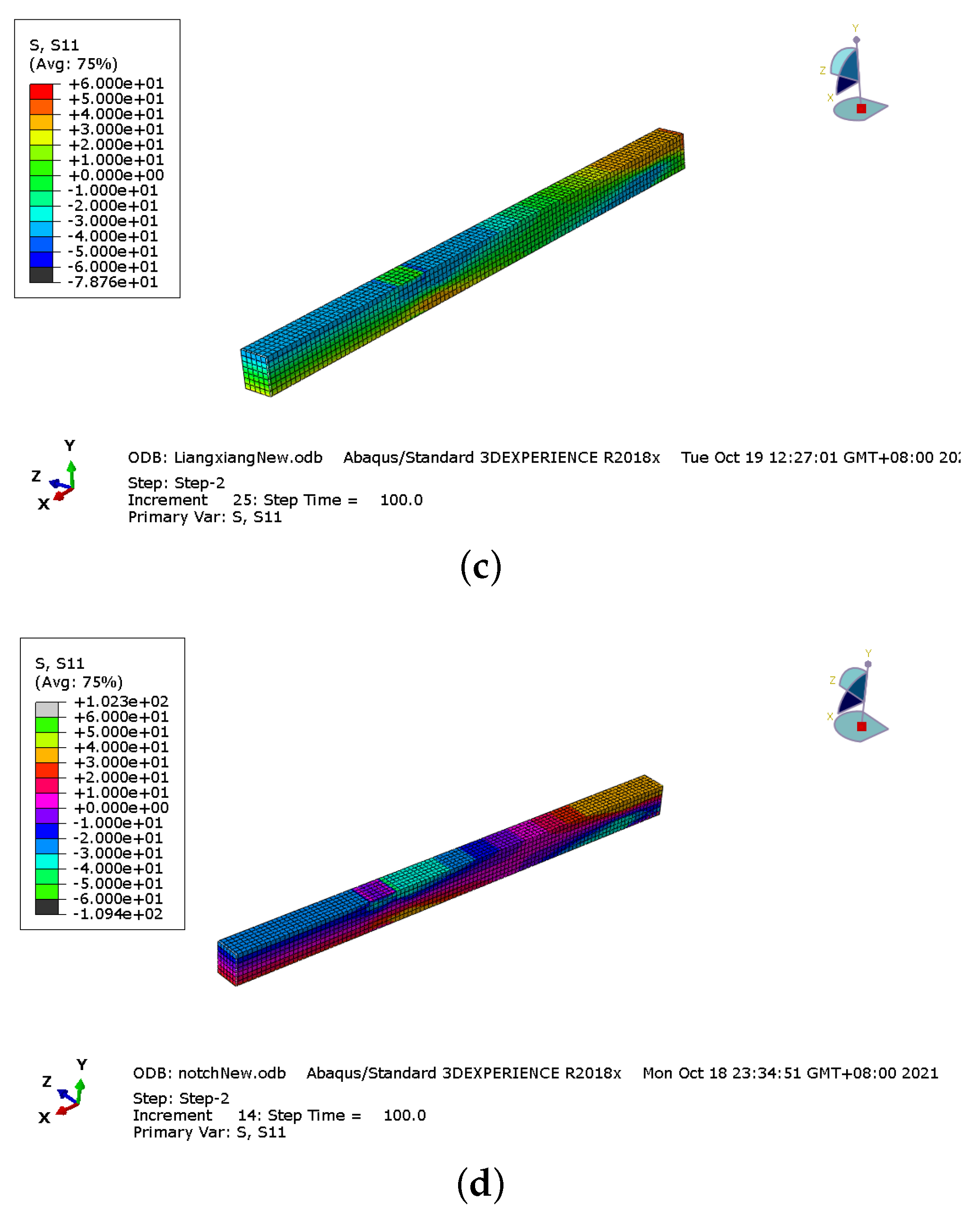
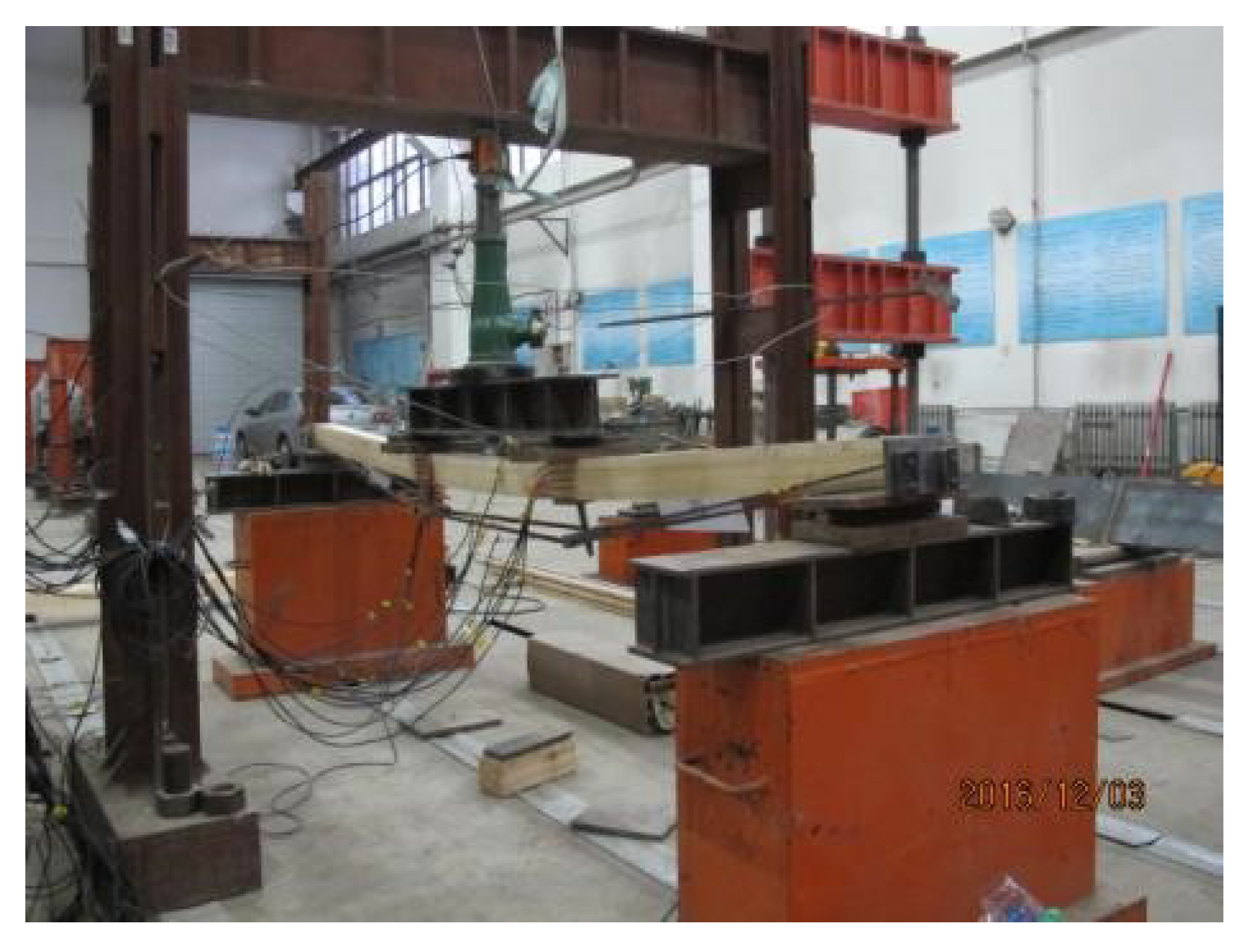



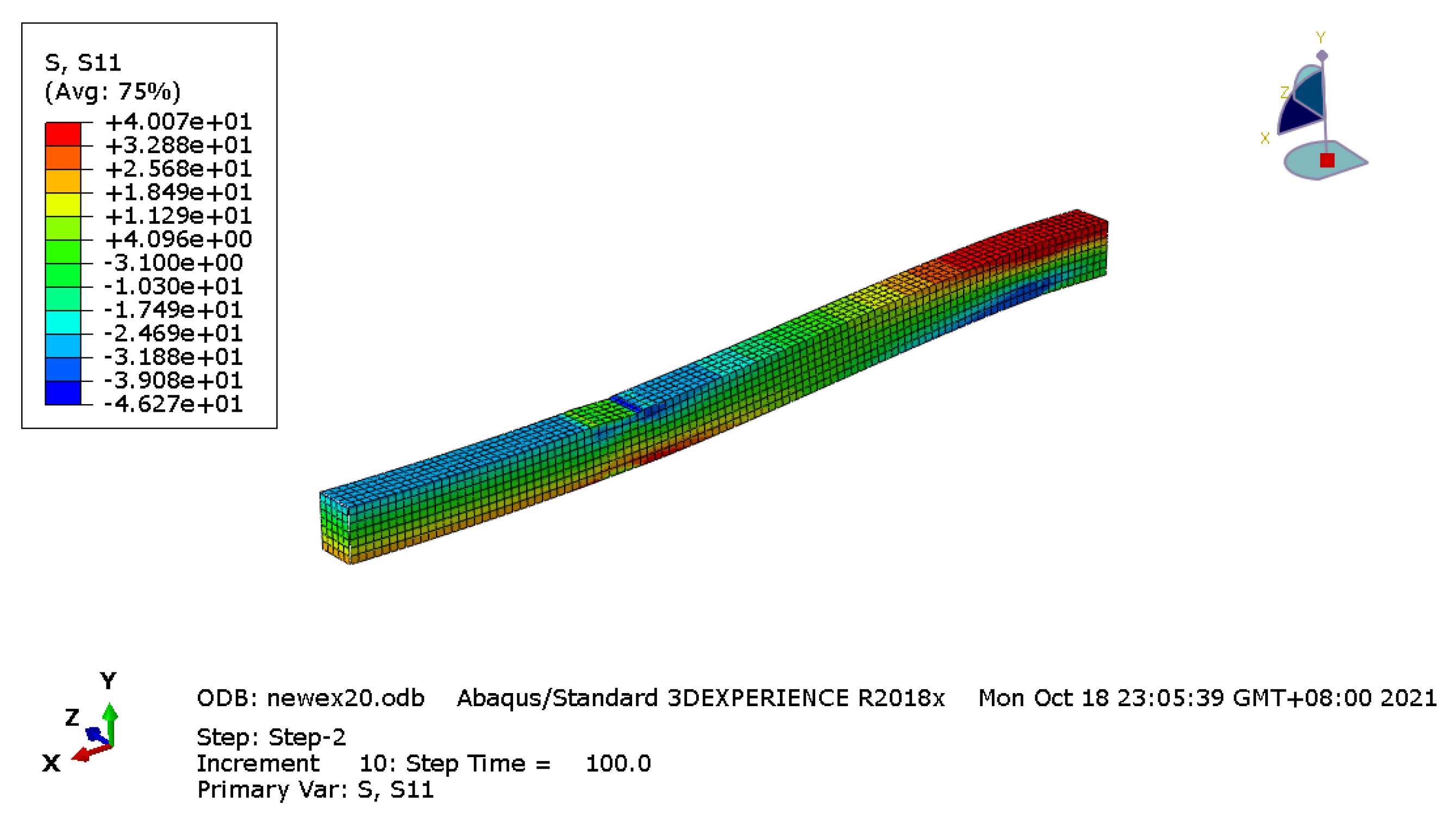
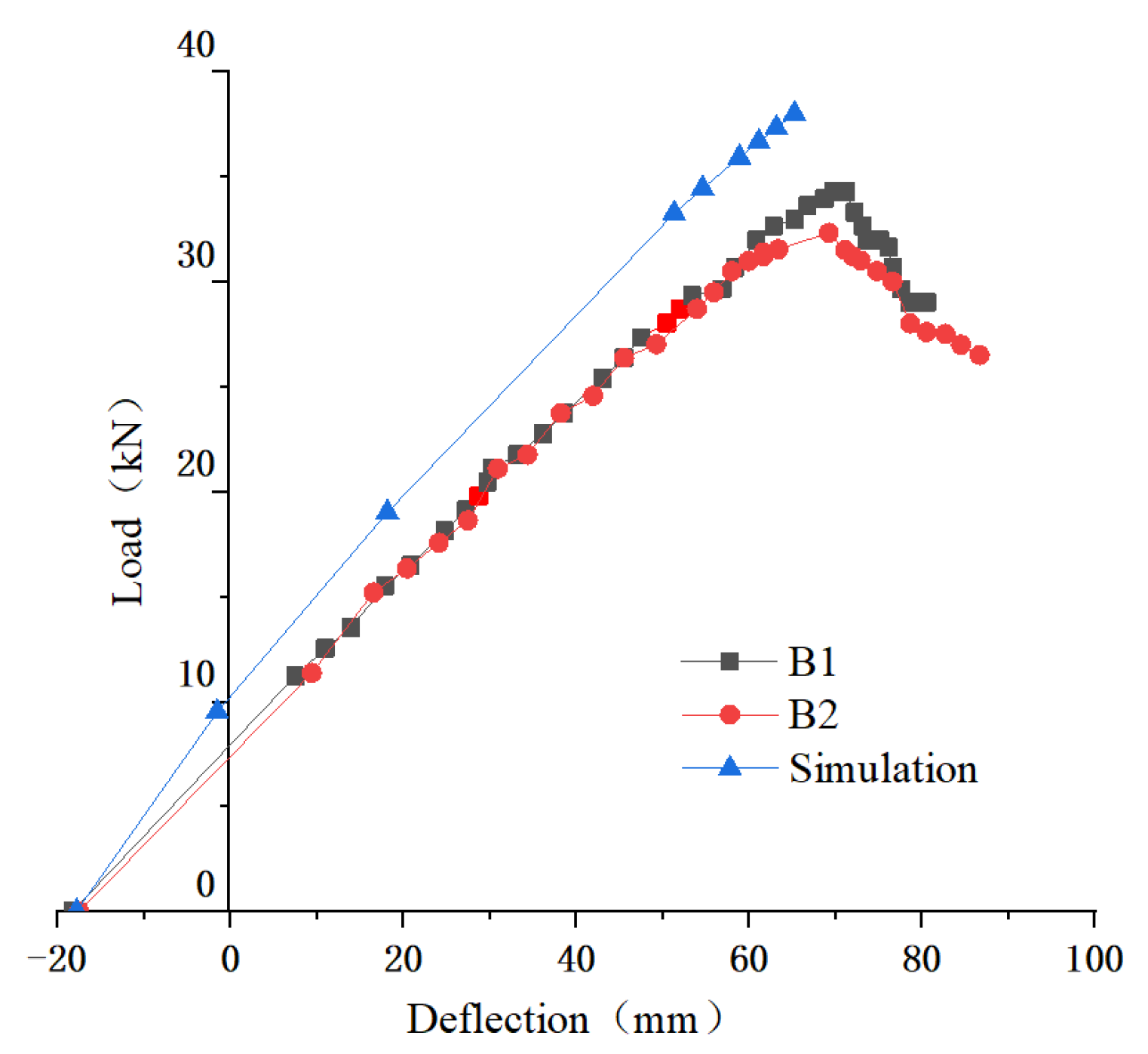
| D | D | D | D | D | D | D | D | D |
|---|---|---|---|---|---|---|---|---|
| 8654.084 | 488.532 | 488.532 | 564.574 | 564.574 | 221.982 | 221.982 | 150.553 | 182.109 |
| Deflection (mm) | Anchoring Device Type | Yield Point Load (kN) | Deflection (mm) | Improvement Rate (%) |
|---|---|---|---|---|
| - | - | 11.34 | 64.94 | - |
| 5 | Mode I | 31.45 | 57.38 | 177.24% |
| Mode II | 25.31 | 53.78 | 123.13% | |
| Mode III | 20.46 | 55.16 | 80.37% | |
| Mode IV | 30.00 | 59.85 | 164.47% | |
| 10 | Mode I | 32.05 | 50.60 | 182.51% |
| Mode II | 25.20 | 52.77 | 122.11% | |
| Mode III | 21.96 | 52.66 | 93.56% | |
| Mode IV | 30.00 | 51.89 | 164.47% | |
| 15 | Mode I | 33.42 | 46.70 | 194.60% |
| Mode II | 25.30 | 51.92 | 123.04% | |
| Mode III | 22.19 | 46.12 | 128.55% | |
| Mode IV | 30.00 | 45.09 | 164.47% |
| Initial Top Pre-Stress (MPa) | Anchoring Device Type | Yield Point Load (kN) | Deflection (mm) | Improvement Rate (%) |
|---|---|---|---|---|
| - | - | 11.34 | 64.94 | - |
| 1 | Mode I | 30.92 | 60.46 | 172.57% |
| Mode II | 22.88 | 64.83 | 101.71% | |
| Mode III | 27.16 | 69.35 | 139.43% | |
| Mode IV | 26.97 | 85.54 | 137.75% | |
| 1.5 | Mode I | 31.29 | 59.74 | 175.88% |
| Mode II | 23.35 | 63.18 | 105.85% | |
| Mode III | 27.18 | 63.45 | 139.64% | |
| Mode IV | 26.97 | 83.42 | 137.80% | |
| 2 | Mode I | 31.86 | 56.94 | 180.87% |
| Mode II | 23.78 | 63.97 | 109.64% | |
| Mode III | 27.42 | 61.19 | 141.71% | |
| Mode IV | 27.10 | 81.55 | 138.91% |
| Type | Peak Compressive (f) | Peak Tensile (f) |
|---|---|---|
| Strength (MPa)/COV(%) | 35/4.63% | 81.32/6.42% |
| Elastic modulus (MPa)/COV(%) | 10,350.2/6.14% | 10,350.2/6.18% |
| Specimen | Size (mm × mm × mm) | Reinforcement Ratio (%) | Pre-Force (kN) |
|---|---|---|---|
| B1 | 3150 × 80 × 100 | 19.24 % | 9 |
| B2 |
| Specimen | A (mm) | Reinforcement Ratio | Pre-Force (kN) | Bearing Capacity (kN) | Deflection (mm) | Failure Mode |
|---|---|---|---|---|---|---|
| B1 | 100 × 80 | 19.24% | 9 | 34.38 | 69.75 | tensile damage |
| B2 | 32.33 | 69.25 | compression damage |
Publisher’s Note: MDPI stays neutral with regard to jurisdictional claims in published maps and institutional affiliations. |
© 2021 by the authors. Licensee MDPI, Basel, Switzerland. This article is an open access article distributed under the terms and conditions of the Creative Commons Attribution (CC BY) license (https://creativecommons.org/licenses/by/4.0/).
Share and Cite
Li, M.; Wu, M.; Guo, N.; Mei, L.; Zhao, Y. Analysis of Four Types of Anchorage Devices for Prestressed Glulam Beam and Experimental Research. Materials 2021, 14, 6494. https://doi.org/10.3390/ma14216494
Li M, Wu M, Guo N, Mei L, Zhao Y. Analysis of Four Types of Anchorage Devices for Prestressed Glulam Beam and Experimental Research. Materials. 2021; 14(21):6494. https://doi.org/10.3390/ma14216494
Chicago/Turabian StyleLi, Mingfei, Mingtao Wu, Nan Guo, Lidan Mei, and Yan Zhao. 2021. "Analysis of Four Types of Anchorage Devices for Prestressed Glulam Beam and Experimental Research" Materials 14, no. 21: 6494. https://doi.org/10.3390/ma14216494
APA StyleLi, M., Wu, M., Guo, N., Mei, L., & Zhao, Y. (2021). Analysis of Four Types of Anchorage Devices for Prestressed Glulam Beam and Experimental Research. Materials, 14(21), 6494. https://doi.org/10.3390/ma14216494






